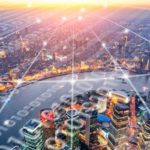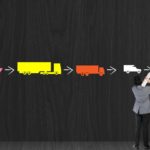Ten social realities that are already changing, thanks to big data
From medicine to finance, large-scale data processing technologies are already starting to deliver on their promise to transform contemporary societies. Far-reaching social changes don’t take place overnight. Little by little, they become part of our daily life, until their revolutionary nature dissipates. Years ago, hybrid cars started turning people’s heads. Today, electric cars are becoming less of a rarity – at least in larger cities.

Something similar is starting to happen with some of big data’s practical applications. Although its most groundbreaking uses are probably still yet to come, big data is already subtly changing some social practices. Here are the ten most significant.
1.- The brains behind smart cities
If large portions of the data sets that are changing societies are generated by what citizens share in social media, and inter-networking of physical devices – the Internet of Things – could there be any better places to capitalize on big data than cities? Today, 53% of the world’s population lives in cities and they are also home to the vast majority of these smart devices.
Big data is the beating heart of smart cities. These are still-futuristic urban areas where garbage truck and bus routes, traffic light timing, and street cleaning will be planned, based on the data supplied by both smart sensors and citizens themselves. Smart cities still have a long way to go before they become a reality. But some, such as Santander in northern Spain, are already hard at work on it.
2.- Taking better care of our health
In order to not only treat, but to prevent their patients’ illnesses, doctors need to have access to their personal data. And the more data they have at their disposal, the better. This premise, as old as medicine itself, is now taking on a new dimension, thanks to big data and the popularity of wearables, such as the smart wristbands that count how many steps we take each day and how many hours we sleep. There are also many apps that help us track our diet and store the relevant information.
In the near future, patients will be able to share all this information from afar with their doctors, who will look for patterns that help explain their ailments or illnesses. All this biometric information can be shared in the cloud, allowing doctors to analyze data from hundreds of patients that share certain morphological traits in order to determine the best treatment. All this information will be shared in the cloud, and adequately protected.
Businesses are also contributing to make headway in this field. Thanks to a partnership signed two years ago between IBM and Apple, iPhone and AppleWatch users can upload their biometric data to Watson’s cloud, where they are analyzed by IBM’s complex artificial intelligence algorithms in real time to determine the best medical treatments.
3.- A tool for medical and pharmacological research
Large-scale medical research is also using big data. In one case in particular, combining large datasets allowed researchers to identify imipramine, an antidepressant, as a possible new treatment for specific lung cancers.
Flatiron Health’s Oncology Cloud is one of the initiatives that have drawn the most attention in the fight against cancer, and Google and Roche Pharmaceuticals have already invested. Flatiron Health is a U.S.-based startup that focuses specifically on software development to fight tumors. Flatiron’s cloud collects data from cancer patients for clinical research purposes. According to the company, 96 percent of the data from cancer patients are not analyzed. And this is a luxury that medical research can no longer afford.
4.- Helping combat major natural disasters
Experts say there are four stages in the management of natural disasters like earthquakes and hurricanes: prevention, preparedness, response and recovery. Big data cannot prevent the extensive damage caused by these natural events, but it can help mitigate them, and in different stages.
A good example of this is Terra Seismic, a company that claims to be able to predict major earthquakes anywhere in the world with 90% accuracy by constantly monitoring satellite data.
In one of the most noteworthy initiatives in the response and recovery stage, BBVA Data & Analytics and UN Global Pulse have studied in detail the impact of Hurricane Odile in Baja California (2014). By using data from payments made through point of sale terminals and ATM cash withdrawals from more than 100,000 BBVA Bancomer customers they were able to obtain approximate indicators of the economic impact and the resilience of the people in the region. This study aims to provide answers to a series of basic questions (e.g. What do people buy to prepare for a hurricane? How long does it take for economic activity to recover? What economic sectors recover first?) as a first step toward establishing an on-site operational method in the event of a disaster.
5.- More transparency in international financial markets
In 2011, the U.S. Financial Crisis Inquiry Commission issued its report on the causes that lead to the global economic and financial crisis and the collapse of Lehman Brothers(2008). In this report, the commission was very clear about the detrimental effects of opacity on the system as a whole.
A few years later, big data has made significant progress in solving this problem. Technical progress in data treatment and the increasing ease of access are allowing financial markets to work in a more efficient manner, making possible frauds much easier to detect in a timely manner.
6.- Making agriculture and livestock more productive
In the 21st Century, farmers no longer look to the sky and rely on their experience over the years to make business decisions. Today, terms that were unknown in this sector until very recently like GPS, big data, drones and wearables are now critical to making agriculture and livestock businesses more profitable.
Thanks to GPS and drones with specialized sensors, these rural businessmen and women can use maps that determine profitability per hectare with fairly good accuracy. They can also detect possible infestations or problems with the irrigation system or with fertilizers. In terms of livestock, the use of collars prevents possible animal losses, and identifies behavior patterns that could indicate illness. A Portuguese startup, Sensefinity, has been one of the pioneering companies in what they call the “smart farm”.
7.- A compass for prices
Determining the right price for products and services is the key to success for many companies competing in extremely competitive markets. McKinsey estimates that if a 1% price increase does not lower volume it translates into an operating profit increase of 8.7% on average. But finding the right price is not easy. The consulting firm says that around 30% of the decisions companies make about prices are erroneous.
The good news is that it’s now easier for companies to make the right decision thanks to big data allowing them to know their customers better. Even the enormous amount of data available to companies opens the door to personalized prices, a possibility with so many implications that the U.S. government published a report on the topic.
8.- New keys to corporate logistics
Managing logistics has always been closely linked to analysis and statistics. What has changed thanks to big data is that now there is much more information - almost in real time - and it is not always structured.

Let’s use a clothing chain’s logistics management as an example. So far they have made their decisions, such as the number of articles in stock and space in warehouses based on structured data. But now they can also use data on winter weather starting earlier than foreseen or an especially rainy spring. They also know from social media like Instagram if a certain article of clothing is in style, like brightly colored leggings for women, for example. If the company is able to analyze all this new information, all of the big data, extract conclusions and apply them, their logistical management, and therefore their business, will be much stronger.
9. Big data transform election campaigns
Just like large corporations, political parties now have an enormous amount of data on citizens. Now they not only know if every city block turns out to vote, but thanks to social networks, they also what media outlets are followed by voters interested in certain politicians. This represents huge progress for their microtargeting techniques in which the campaigns target very specific voters with the topics that interest them.
Some social scientists have warned that this approach to election campaigns actually changes the political climate. Now candidates focus more on galvanizing their supporters. They know exactly who they are and it is cheaper and faster to convince them than to fight for the undecided voters. As a result, societies become too polarized and disregard more moderate positions.
10. A new genre of news: data journalism
Journalists frequently complain about digital disruption. However, apart from breaking away from the business model based on printed products and its severe impact on jobs, technology also offers new opportunities for the sector.
One of the biggest opportunities lies in so-called data journalism, a new genre of journalism that basically consists of analyzing, organizing and contextualizing the deluge of data on a very specific topic. Thanks to big data, journalism can now accurately explain when are where the most traffic jams occur and the crime rates in each neighborhood. But data journalism is not just an analytical tool. It also serves to break news stories - deviations from the statistical pattern normally are news - and possible corruption, making society more transparent.